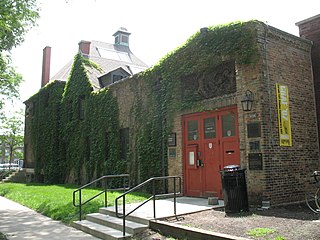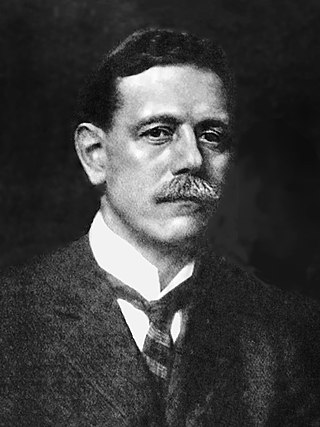
Ogle County is a county in the northern part of the U.S. state of Illinois. According to the 2020 United States Census, it had a population of 51,788. Its county seat is Oregon, and its largest city is Rochelle. Ogle County comprises Rochelle, IL Micropolitan Statistical Area, which is also included in the Rockford-Freeport-Rochelle, IL Combined Statistical Area.

Oregon is a city in and the county seat of Ogle County, Illinois, United States. The population was 3,721 in 2010.

Northern Illinois University (NIU) is a public research university in DeKalb, Illinois, United States. It was founded as Northern Illinois State Normal School in 1895 by Illinois Governor John P. Altgeld, initially to provide the state with college-educated teachers. In addition to the main campus in DeKalb, it has satellite centers in Chicago, Naperville, Rockford, and Oregon, Illinois.

Lorado Zadok Taft was an American sculptor, writer and educator. Part of the American Renaissance movement, his monumental pieces include, Fountain of Time, Spirit of the Great Lakes, and The Eternal Indian. His 1903 book, The History of American Sculpture, was the first survey of the subject and stood for decades as the standard reference. He has been credited with helping to advance the status of women as sculptors.

The White Rabbits were a group of women sculptors who worked with Lorado Taft at the World's Columbian Exposition in 1893.

The Eternal Indian, sometimes called the Black Hawk Statue, is a 48-foot sculpture by Lorado Taft located in Lowden State Park, near the city of Oregon, Illinois. Dedicated in 1911, the statue is perched over the Rock River on a 77-foot bluff overlooking the city.

Fountain of Time, or simply Time, is a sculpture by Lorado Taft, measuring 126 feet 10 inches (38.66 m) in length, situated at the western edge of the Midway Plaisance within Washington Park in Chicago, Illinois, in the United States. The sculpture is inspired by Henry Austin Dobson's poem "Paradox of Time". Its 100 figures passing before Father Time were created as a monument to the 100 years of peace between the United States and the United Kingdom following the Treaty of Ghent in 1814. Father Time faces the 100 from across a water basin. The fountain's water was turned on in 1920, and the sculpture was dedicated in 1922. It is a contributing structure to the Washington Park United States Registered Historic District, which is a National Register of Historic Places listing.

Nellie Verne Walker, was an American sculptor best known for her statue of James Harlan formerly in the National Statuary Hall Collection in the United States Capitol, Washington D.C.

The Oregon Public Library is located in Oregon, Illinois, United States, the county seat of Ogle County. The building is a public library that was constructed in 1909. Prior to 1909, Oregon's library was housed in different buildings, none of which were designed to house a library. The library was built using a grant from wealthy philanthropist Andrew Carnegie. The grant was obtained after Oregon's citizens voted to change Oregon's library from a city library to a township library. The building was completed by 1908 but the library did not begin operation until 1909.

The Oregon Commercial Historic District is a historic district in Oregon, Illinois, that has been listed on the National Register of Historic Places since 2006. The district is roughly bordered by Jefferson, Franklin, 5th and 3rd Streets in Oregon. It is one of six Oregon sites listed on the National Register and one of three to be so listed since the turn of the 21st century. The other two are the Oregon Public Library, listed in 2003, and the Chana School, listed in 2005.

The Ogle County Courthouse is a National Register of Historic Places listing in the Ogle County, Illinois, county seat of Oregon. The building stands on a public square in the city's downtown commercial district. The current structure was completed in 1891 and was preceded by two other buildings, one of which was destroyed by a group of outlaws. Following the destruction of the courthouse, the county was without a judicial building for a period during the 1840s. The Ogle County Courthouse was designed by Chicago architect George O. Garnsey in the Romanesque Revival style of architecture. The ridged roof is dominated by its wooden cupola which stands out at a distance.

The Soldiers' Monument is a memorial consisting of three statues, one in bronze and two in marble by sculptor Lorado Taft, grouped around an exedra designed by the architectural firm of Pond and Pond. It is located in Oregon, Illinois, the county seat of Ogle County, Illinois. It was dedicated in 1916. The sculpture is part of the Oregon Commercial Historic District. The district was designated and listed on the National Register of Historic Places in August 2006.

Lowden State Park is an Illinois state park on 207 acres (84 ha) in Ogle County, Illinois, United States. It is named for Governor Frank Orren Lowden, who served from 1917 to 1921, and is home to The Eternal Indian, a statue by Lorado Taft. Along with eleven other parks, it was briefly closed after budget cuts in 2008.

The Lorado Taft Midway Studios are a historic artist studio complex at South Ingleside Avenue and East 60th Street, on the campus of the University of Chicago on the South Side of Chicago. The architecturally haphazard structure, originating as two converted barns and a Victorian house, was used from 1906 to 1929 as the studio of Lorado Taft (1860-1936), one of the most influential sculptors of the period. A National Historic Landmark, it now houses the university's visual arts department.

Irving Kane Pond was an American architect, college athlete, and author. Born in Ann Arbor, Michigan, Pond attended the University of Michigan and received a degree in civil engineering in 1879. He was a member of the first University of Michigan football team and scored the first touchdown in the school's history in May 1879.
Pond and Pond was an American architecture firm established by the Chicago architects Irving Kane Pond and Allen Bartlitt Pond.
Leonard Crunelle was a French-born American sculptor especially known for his sculptures of children. Crunelle immigrated with his family to the United States and worked as a coal miner in Decatur, Illinois. Lorado Taft discovered him as a youth and brought him to Chicago where he was an apprentice to the sculptors decorating the 1893 World's Fair Horticultural Exhibit. He studied at the Art Institute of Chicago with Taft.

The Main Library is a historic library on the campus of the University of Illinois Urbana-Champaign in Urbana, Illinois. Built in 1924, the library was the third built for the school; it replaced Altgeld Hall, which had become too small for the university's collections. Architect Charles A. Platt designed the Georgian Revival building, one of several on the campus which he designed in the style. The building houses several area libraries, as well as the University Archives and the Rare Book & Manuscript Library. The Main Library is the symbolic face of the University Library, which has the second largest university library collection in the United States.

Ralph Elmer Clarkson was an American painter, known primarily for his portraits of public figures in and around Chicago.
William A. Harper was a Canadian-born artist best known for his landscape paintings, and is represented in both the Metropolitan Museum of Art in New York City and the National Museum of African American History in Washington, D.C. Harper was born in the village of Canfield, near Cayuga, Ontario, Canada, and immigrated to Illinois in 1885. He graduated from the Art Institute of Chicago (“AIC”) in 1901, and subsequently studied at the Académie Julian in Paris, France. Harper's paintings were regularly accepted in juried exhibitions of the AIC and the Society of Western Artists and were acknowledged with multiple awards.




















